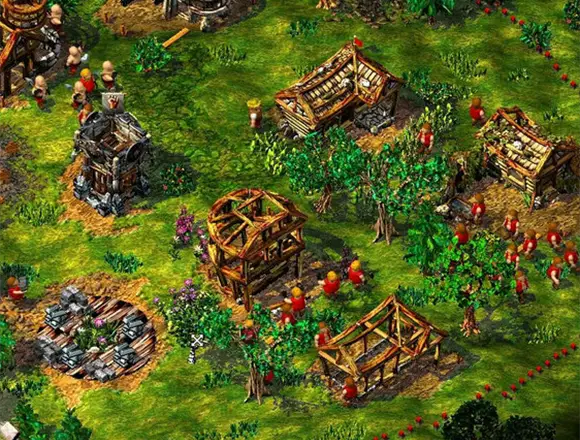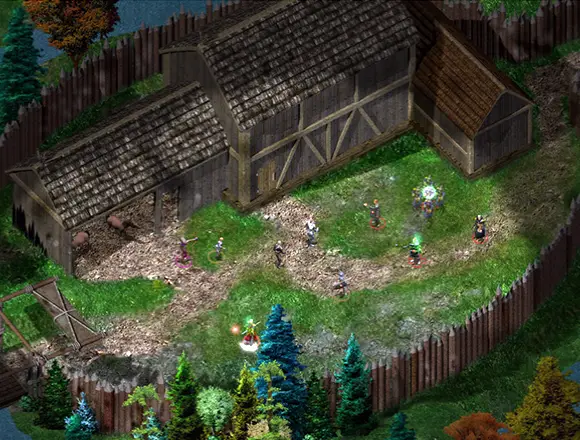This article is an overview of the isometric visual style. The goal of this article is to explain the basics of isometric projection as it relates to video games, so you can understand it intuitively. To understand what isometric games are, I will explain some basic definitions, give some examples of projections, and finish with several examples of popular video games that use the isometric visual style.
Introducing Isometric Games
In this section, I will explain what isometric games are, and give a brief history of this visual style.
What Are Isometric Games?
Isometric games are a type of video game in which the world is presented as a 3D world in a 2D environment. This illusion is achieved by using an orthographic projection, specifically isometric projection, which is a fancy way of saying the player’s view of the game world is angled to give the illusion of depth on a 2D screen. Later in this article, we will compare the perspective projection to the isometric projection to better understand isometry.
Brief History of Isometric Games
The first games to use an isometric projection were arcade games in the early 80s. Games like Treasure Island, Zaxxon, and Congo Bongo demonstrated the isometric projection visual style. Later, games like Blue Max, Ant Attack, and Knight Lore entered the home computer market and quickly gained popularity. These types of games are still popular to this day. Games like Diablo, Civilization, and the SimCity series are classic games in the isometric visual style category.
Projections
The section explains the basics of projections, focusing on isometric projection, and outlines the benefits of this style in a few game genres.
What Is a Projection?
A projection is a mathematical formula that converts every point in a 3D world to a flat 2D space. This technique is necessary in video games, since many games include 3D worlds that has to be presented on a 2D screen. In order to create a realistic feel that we are in a 3D world, we use some type of projection to ‘flatten’ the objects in the game world and fit them into a 2D screen. There are several types of projection categories and subcategories. The most popular ones are Perspective, Oblique, and Orthographic.

In order to understand what an isometric projection is, we first need to know what an orthographic projection is. An orthographic projection is a way to describe the world with parallel lines. This definition will be clearer if we compare Perspective with Orthographic projection.
Perspective Projection
In Perspective projection, we want to feel like we are in a 3D world, where close objects seem bigger, and distant objects seem smaller. If you look outside, you will probably see the ground, trees, cars, and people. But if you look in the distance, you may see mountains. The mountains look small to you even though, in reality, they are huge, while the cars and people look pretty much the same. This is because the image your eyes are seeing has a vanishing point. A vanishing point is a point in the distance, where all lines meet. all the lines of the objects you see converge to a single vanishing point in the distance.

In the image above, you can see the road gets smaller as it goes further away from the viewer. The point where the road ends and you can’t see further, is called the Vanishing point.
Orthographic Projection
In contrast, an Orthographic projection doesn’t have a vanishing point; all lines are parallel. This kind of projection has a distinct look – an object will have the same size no matter the distance from the camera. An isometric projection is a type of an orthographic projection, where the camera is angled to look on the object evenly from all sides (120 degrees on each dimension).

The city image above illustrates the isometric style in games. You can see that all buildings and roads have a similar look, even though the objects in the upper portion of the illustration should be smaller since it’s further away from the camera. There is no real depth in the image, and yet all 3 dimensions of each object are equally visible to the viewer.
Isometric Gameplay
The most popular game genres that use isometric projection (and orthographic projection in general) are strategy games and role-playing games (RPGs).
In strategy games, the player has to build something, whether it’s an army, a city, or any type of resource that will give him an advantage over the enemy or help him reach his goal. The isometric perspective allows the player to see the battlefield or terrain from a bird’s-eye view, making it easier to be more strategic and plan his next move.
Role-playing games often have big open worlds for the player to explore. The angled view makes the world feel larger and more in-depth, making exploration more exciting and easier to control.
Popular Isometric Games
The Isometric visual style was incorporated in many games throughout the history of video games. We will explore some of the most popular isometric game series ever created.
1. The Settlers Series
The Settlers is a real-time strategy game taking place in a medieval world, where the player controls a group of settlers who must establish and expand a colony while facing various challenges.
The Player must gather resources such as wood, stone, and food to construct buildings and expand their colony. He must also manage the colony’s economy by producing goods such as weapons and tools, and trading with other colonies.
The game features a military aspect where players must train and equip soldiers to defend their colony from enemy attacks. It has a complex economic simulation and a great balance between the economic and military aspects of the game.

2. Baldur’s Gate Series
Baldur’s Gate is an RPG set in the fantasy world of the Forgotten Realms. The game features a party-based role-playing system, where the player controls a party of characters and engages in battles with enemies using real-time combat.
The party can explore the surrounding area, complete quests, and interact with various characters.
Baldur’s Gate has a series of expansions, and it is considered a classic in the RPG genre. It is praised for its deep story, complex characters, and challenging gameplay.

3. SimCity Series
SimCity is a classic city-building simulation game series, where the player takes on the role of a city mayor and builds, manages, and develops his own city. In the game, the player starts with a piece of land and has to build infrastructure such as roads, power plants, and residential, commercial, and industrial zones.
The player must also manage the city’s budget, deal with natural disasters, and try to keep the citizens happy by providing them with essential services like schools, hospitals, and police stations. The player can also trade and negotiate deals with neighboring cities to get resources and improve the city’s state.
SimCity was a huge success and has several sequels and modified versions. This game is so popular that it has huge communities of gamers, all around the world, playing it to this day.

Final Thoughts
The isometric style of games had a huge impact on my life. Some of my best memories are from playing these types of games. These games are not just for fun, I actually learned several skills from playing them, such as strategy and resource management. These skills may sound like they can only apply to video games, but they are not. These skills are actually very useful in life, whether you realize it or not.
I expect that in the future, we will see more isometric games that continue to push the boundaries of what is possible with this perspective and offer new and exciting gameplay experiences. The isometric perspective has a lot of potential and it will be interesting to see how developers continue to use it in new and innovative ways over the next few decades.
You can read more about games and game development in my Night Quest Games Blog.
If the information in this article was helpful to you, please consider supporting this blog through a donation. Your contributions are greatly appreciated and allow me to continue maintaining and developing this blog. Thank you!
Attributions
Vanishing Point image was taken from hulv850627 on Freepik.
The Isometric City image was provided by Image by macrovector on Freepik.
The article featured image was created using the image of vectorpocket on Freepik.



